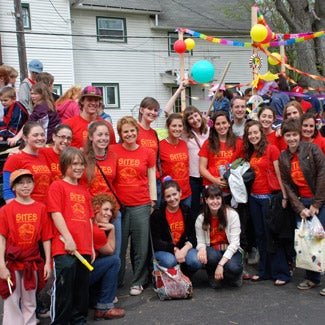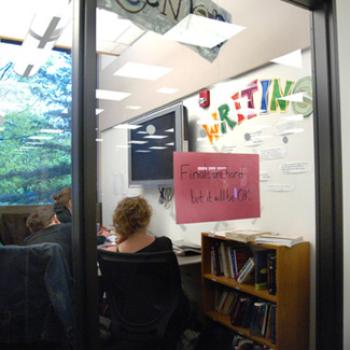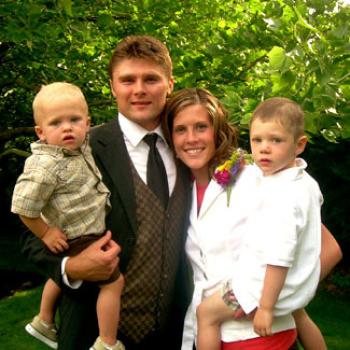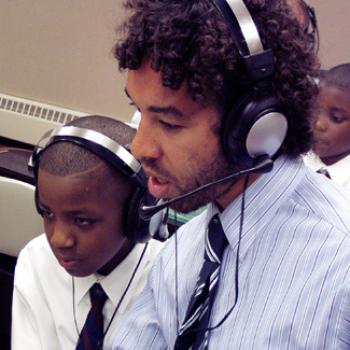On Oberlin’s SITES program
Prof. Kim Faber
“What began as one mom’s hope to have a language program for her 5-year old son is now providing the opportunity for every elementary-school child in Oberlin to experience another language.”

In 2003, my four-year old son was nearing the exciting and scary moment of entering Kindergarten. As a linguist, I wondered about the school district’s foreign language program. To my dismay, I found that the Oberlin public schools taught no World Languages until high school, when Spanish and French were available, though I was told that even there the program was not especially dynamic.
As a Spanish language instructor at Oberlin College since 1999, I had always hoped my kids--who speak English and Dutch--would be able to learn Spanish in school. I had come from California, where I was accustomed to public-school World Language programs beginning in middle school. So it was disconcerting to know that my children would have to wait until ninth grade to begin learning Spanish. My husband and I thought about the situation a lot. Neighboring private schools offered more options, but we really preferred to keep our children in the public schools.
In the spring of 2005, I was teaching a course called “Linguistics for Language Students” - which looked at various forms of bilingual education and their effects on children, among other things - when the Center for Service and Learning approached faculty to encourage them to enrich their courses with a Community-Based, Service-Learning component. I wondered if I could have my linguistics students apply some aspect of what they were learning in the Oberlin community. I asked the class if they would be interested in teaching the languages that they knew, or were studying, to children in the Oberlin public schools. This being Oberlin, and my students being exceedingly creative and ambitious, they were immediately on board.
In the weeks following, I spoke with the Superintendent, school principals, parents and community members to get a clear picture of what sort of program would be best. The Superintendent informed me that the schools had in fact surveyed parents two years previously as to which language(s) they wanted their children to learn in school. The large majority, it turned out, wanted Spanish. I told him that this only made things easier, since I taught Spanish at the college. Since I wanted to be sure that nobody’s child was in any way privileged over another, I immediately rejected the idea of an after-school program, a “lunch bunch,” or similar scenarios. My personal feeling is that foreign or “World” languages should be an integral part of every child’s education beginning in the early years.
In the beginning I met with a fair amount of resistance and skepticism. Would I start something and then drop the ball? Would even well-meaning college students at some point be unable to prioritize their work in the schools over their many other commitments? I was told that in the past, college students and faculty had launched well-meaning programs, only to have them peter out once the initial research goals were met, or once personal energies were exhausted. I made a pact with the then-principal of Prospect School, Linda Dawson, to “under-promise and over-deliver.”
And so, with the support of the public schools’ administration, and the leery but obliging Kindergarten and 3rd-grade homeroom teachers, “Spanish In The Elementary Schools,” or Oberlin SITES, was initiated in the fall of 2005. Sixteen Oberlin College students began team-teaching Spanish in eight different classrooms in these two grades (four classrooms per grade), 20 minutes twice a week. There was a logic to this, as the Oberlin public elementary schools are divided into two buildings: one for K-2nd grade and one for 3rd-5th grades. The initial idea was to begin at the lowest grade taught at each school, adding one grade each year until, in three years’ time, every grade K-5 (27 classrooms) would offer Spanish.
The fact that some teachers were initially resistant has to be understood in context. It is important to realize that “No Child Left Behind” has put teachers under an enormous amount of pressure to prepare their students for a litany of standardized tests. Schedules have become much less flexible than they used to be. Nearly every teacher in the schools has indicated that he or she feels strapped for time. Even those who feel that languages are best learned when one is young have a hard time justifying one more obligation in their already jam-packed daily schedules.
Still, SITES’ first pilot semesters were a success, and most parents were enthusiastic and eager to see the program continue. Even so, it wasn’t until the spring of 2006, when Geoff Andrews was hired as the new school superintendent, that things really got moving. Even before starting his job, Andrews called to tell me that he shared my vision for teaching foreign languages in the schools and that he wanted to work together to see what we could do. To say I was thrilled is an understatement. It was exciting to realize that I was going to have this kind of support in the system.
Our shared vision encouraged us to be ambitious. We decided to provide Spanish for all students - grades K-5 - the very next year (a year earlier than initially planned). I wasn’t sure if I’d be able to convince enough Oberlin College students that this program was something they should join - especially since I would need an army of at least 54 student-teachers (one pair for each of the 27 classrooms). But in true Oberlin form, students came out in droves: 65 students rallied around the program that semester. Since I only needed 54 students to run the program in the public schools, we could afford to have students teaching Spanish to 2- to 5-year old kids in the Oberlin Early Childhood Center - which my four-year old daughter happened to be attending.
Suddenly a program that had been only a dream took shape and quickly increased in strength and effectiveness. The program itself became more academically rigorous as well. The students not only taught Spanish classes (and taught them very well), but also enrolled in a new one-credit practicum course that I taught to help prepare them for their teaching experiences. (Course credit until then had been given through private readings.) As if these increased expectations weren’t enough, I asked them to help me create a full-scale curriculum for the program, which is now being used by Spanish teachers all over the country.
That spring also led to a big monetary boost for the program (which until then was run primarily on volunteer labor and many resources from my own home) when the class of 2007 gave $2000 to SITES as part of their senior gift. The class of 2008 followed suit, contributing nearly $6,500. Both gifts allowed the SITES program to buy hundreds of books, music CDs, and other teaching materials to enrich the Spanish classes. Resources like these, of course, take up space; that was our next hurdle. This one was easily overcome, however, as Ray English, Director of Libraries allowed SITES to not only inhabit a room (Mudd 201), but also to process materials through the library’s bar-coding system. Thanks to both senior classes and the library, SITES instructors now have a fully equipped resource center at their disposal.
Now, four years after the SITES program began, it continues to thrive and grow. My “Linguistics for Language Students” course has recently been transformed into a 4-credit Applied Linguistics course called “Language Pedagogy: The Theory & Practice of Teaching and Learning Languages” (EDUA 101) that discusses such things as what it means to know a language, and how to teach languages effectively. The course includes a practicum in which students work as teachers or tutors in the language(s) of their competency, including English. Spanish-speaking students who are accepted into the SITES program teach Spanish in the Oberlin Public schools. The course is open to all students, regardless of their linguistic background. Meanwhile, several neighboring schools have written to express interest in introducing the SITES program in their schools.
What began as one mom’s hope to have a language program for her 5-year old son is now providing the opportunity for every elementary-school child in Oberlin to experience another language.
Currently SITES is helping to make it possible for Oberlin Public schools to be the first district in Ohio to offer an IB (International Baccalaureate) curriculum grades K-12, since IB requires that students receive instruction in a second language beginning in the primary years.
So thank you Oberlin College SITES instructors past, present and future, for your creativity, energy, and support of a program that you have worked so hard to make a success. You are all amazing in your dedication to changing the world one person at a time.
Visit Oberlin SITES at oberlinsites.org to learn more.
Tags:
You may also like

On embracing writing
“Oberlin revolutionized the way I think about writing - which in turn shaped me not just as a learner but also as an individual.”
Anna Zeemont ’13

On opportunity
“I spent many years grappling with what type of profession I wanted to pursue in my life. I considered medicine, legal work, and many other paths. But one thing always remained the same: my passion...
Chase Palmer ’08

Contributed by Prof. Laurie McMillin
“Jabali left Oberlin in 2000 with a degree in Biology and no set plans. But he knew he wanted to teach... At the age of 27, he became the principal of Excellence Charter School in Bedford Stuyvesant...
Jabali Sawicki ’00